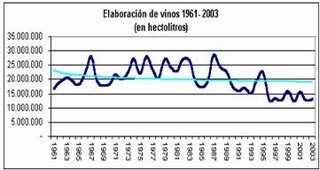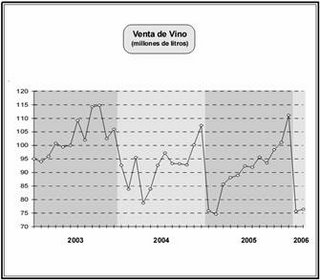Una crónica de “Vinos y Bodegas” en La Rural
18 de Septiembre de 2006
Desde el miércoles pasado me he sentido muy enfermo con tos, faringitis, y un poco de fiebre. Pero cuando llegó la noche del sábado, me sentí mucho mejor después de una dosis sustantiva de antibióticos que había empezado la noche del jueves. El sábado fue mi cumpleaños y hacía varios días que no salía de la casa. Yo sabía que era imperativo que fuera a este evento que sólo tiene lugar una vez cada año.
Así, me levanté de la cama, me bañé y me vestí con la única camisa respetable que traje a BsAs. Fui a un cajero automático porque me di cuenta de que sólo tenía un billete de cien pesos y los taxistas usualmente no tienen cambio. Había pensado que habría podido tomar el colectivo a Plaza Italia, donde queda La Rural, pero tenía prisa porque el sábado era mis cumpleaños y mi familia argentina planeó una fiesta que empezaría a las 9:30 pm.
Subí a un taxi en la esquina de la Avenida Pedro Goyena y Emilio Mitre. Mi aventura había comenzado. Saqué mi cuaderno de castellano de mi mochila para releer lo que Lucia y yo habíamos escrito para introducirme a la gente de vino en la exposición. Intenté memorizarlo:
“Soy un estudiante universitario de EEUU y estoy investigando la industria vitivinícola argentina y su crecimiento durante los últimos 15 años.”
“Necesito preguntar si usted conoce a gente del área que yo pueda entrevistar durante el viaje a Mendoza que realizaré a principios de octubre y que durará 10 días.”
El viaje tardó una media hora de mi zona de Caballito hasta Plaza Italia que queda en el barrio de Palermo. Ésa era la primera vez que estaba en Palermo desde el año pasado. Tengo sentimientos variados sobre Palermo. En mi programa del año pasado la mayoría de los norteamericanos vivieron allí y yo tenía la imagen de un barrio lleno de norteamericanos, una imagen que ningún norteamericano quiere tener cuando viaja fuera del país. También, había tenido una experiencia bastante mala en Plaza Serrano: es una historia larga; lo que ocurrió es que al pagar la entrada de un pub, el hombre de la puerta me estafó. Pero, mientras pasaba por las calles en el taxi tuve que admitir que Palermo es un barrio muy lindo, con zonas residenciales y boutiques en casi todas las esquinas.
La Rural es un predio para congresos y eventos grandes. Por ejemplo, la competición internacional de tango tuvo sede allí hace algunas semanas. Este evento que se llamaba “Vinos y Bodegas” sólo ocupó una parte pequeña del complejo de espacios. Por accidente, entré a otro lugar que tenía una exposición de “la vida country”.
Después de pagar al taxista (12 pesos, exactos) bajé y encontré la cola para comprar las entradas. Las entradas salían 25 pesos y cuando intenté pagar con mi billete de cien el hombre de la caja me preguntó en una manera que me recordó Nueva York, “¿No tenés una de cinco?” Respondí que no, no tenía una de cinco, y sentí la necesidad de mostrarle mi cartera. Él me dedicó una mirada desagradable otra vez, y me dio la entrada y el cambio. No me acuerdo bien, “era yo el cliente, ¿o no?”
Entré a La Rural y la primera vista fue espectacular. Detrás de los edificios de La Rural y de la bandera gigante de la Argentina, se podía ver el “skyline” de Palermo que nunca había visto; era muy linda esta perspectiva. Me sorprendió mucho porque no se veía bien desde la calle externa a La Rural.
Ingresé a la exposición y decidí hacer un paseo antes de presentarme a la gente. Caminé por los alrededores y reconocí algunos nombres de las bodegas, pero no la mayoría. Había impreso un plano de la exposición unos días atrás pero no pude encontrarlo porque salí muy apurado. También, me di cuenta de un problema bastante malo. Yo quería introducirme en el mundo de las bodegas de Mendoza, pero este evento acogía gente de muchísimas provincias y regiones del país como Salta, La Rioja y Patagonia. Más tarde, aprendí que debía buscar con anticipación la botella de cada bodega mendocina y despues conversar con la gente vinculada a la industria del vino.
Durante mi breve paseo por los alrededores me di cuenta de un fenómeno muy destacable de este evento. Las mujeres que fueron contratadas por las bodegas eran muy lindas. Es decir, eran modelos y algunas podían ser supermodelos. Era un placer contar con bellezas argentinas en mi trabajo de campo.
Después de caminar por todos lados diciéndome a mi mismo “Sí Gavin, tenés el coraje para hablar con gente que no conocés en una lengua que no es la tuya” decidí empezar a hablar con unas de las mejores mujeres que había visto allí y que estaba en el stand de La Nación. Me acerqué allí porque quería saber si ella podía contactarme o darme la tarjeta de algún periodista de ese diario que escribiera sobre vino. Desgraciadamente ella no tenía idea de lo que le pedía y, excepto por su buena presencia, de nada me sirvió; sólo me dijo: “podes ver en el periódico.” Detesto cuando la gente me dice cosas muy obvias.
Pero bueno, ya no era un neófito en “Vinos y Bodegas” y estaba dispuesto a hablar con más gente especializada. Hacia la noche, había entregado mi tarjeta a veinte personas y había recibido de otros unas 10 tarjetas. La persona más importante que conocí fue un representante de “Bodegas de Argentina” que es una organización que hace marketing para las bodegas. Él me dio contactos en Mendoza y una lista de todas las bodegas de las que se encarga Bodegas de Argentina, con sus teléfonos y mails para comunicarme con ellos. Esta lista me ayudará mucho durante las semanas que vienen.
Después de todo el estrés, decidí probar algunos vinos. Tenía algunos minutos antes de regresar a casa y me dije: “Pagué veinticinco pesos, ¿Por qué no?” Los vinos eran buenos; lo único que sé es que un vino no es bueno si tiene un envase de cartón así que si tuvieras que hacer una crítica como un sommelier consultaría a SaltShaker.
Cuando salí de La Rural pensé que mi noche de vinos había terminado. Al llegar a mi casa mi familia argentina me bombardeó con regalos vinculados con el vino. Gerardo (mi padre argentino) me regaló un set de vino, que tiene un mecanismo específico para abrir el vino, para cortar el papel de la botella, y un termómetro. María Eugenia (mi mamá argentina) me dio dos copas grandes que sirven para catar el vino. Son “re-copados” (no pude resistirme a la palabra entre tantos vinos). Y Pablo (mi hermano argentino), Andrea (su novia), y Tony (un norteamericano que vive en mi casa) me dieron tres botellas de vino, un vino blanco, un vino rosado, y un vino tinto.
Así que, no estaría mal decir que éste fue un día de “Cumpleaños de vinos.”












